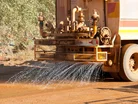How do Mining Companies Mitigate Environmental Damage?

Environmental mitigation in mining operations has moved beyond regulatory compliance to become central to operational strategy. Mining companies now integrate environmental protection into their planning phases, from initial surveys through to site closure and rehabilitation.
The financial imperatives are clear. Environmental incidents can halt production, trigger regulatory investigations, and damage relationships with host communities. These risks have pushed mining companies to develop comprehensive mitigation strategies.
Water management stands at the forefront of these efforts. Mining operations require significant water resources for mineral processing and dust suppression. Companies now implement closed-loop water systems to minimise consumption and prevent contamination.
"Our water recycling systems at the Quellaveco copper mine have reduced freshwater usage by 85% compared to traditional methods," says Tom McCulley, CEO of Anglo American Crop Nutrients. "This technology allows us to maintain production while protecting local water resources."
Mining companies tackle waste challenges
The management of mine waste, particularly tailings, has received heightened attention following recent dam failures. Mining companies have responded with new approaches to tailings storage and processing.
Rio Tinto has developed dry-stack tailings facilities at several sites. This method removes water from tailings before storage, reducing both the physical footprint and potential environmental risks.
"Dry-stack technology represents a step-change in how we manage tailings," notes Peter Toth, who is now EVP & Chief Development Officer with Newmont, but at the time of speaking was Group Executive, Strategy & Development, with Rio Tinto. "The initial investment is higher, but the long-term environmental benefits justify the cost."
Land rehabilitation programs in mining
Modern land rehabilitation programs utilise geographic information systems and drone technology to monitor restoration progress. These tools enable companies to track vegetation growth and soil stability with precision.
Companies now begin rehabilitation while mining operations continue, rather than waiting until closure. This progressive approach reduces costs and accelerates the return of land to productive use.
Biodiversity protection has emerged as a key focus. Mining companies establish buffer zones around sensitive habitats and develop corridors to maintain wildlife movement.
"We've implemented biodiversity offset programs that protect three times the land area affected by our mining operations," says Mark Cutifani, CEO of Anglo American. "These initiatives support local ecosystems while maintaining our social licence to operate."
Renewable energy in mining
Mining companies have also expanded their use of renewable energy. Solar and wind installations power remote operations, reducing both carbon emissions and operational costs.
"The transition to renewable energy at our operations has reduced our carbon footprint by 30%," says Jakob Stausholm, CEO of Rio Tinto. "This shift aligns with our commitment to net-zero emissions by 2050."
Environmental monitoring has evolved through the adoption of real-time sensors and satellite technology. These systems alert operators to potential issues before they develop into problems.
Indigenous knowledge increasingly informs environmental management strategies. Mining companies collaborate with local communities to incorporate traditional land management practices into their restoration efforts.
"Traditional ecological knowledge has improved our understanding of local ecosystems," says Jean-Sébastien Jacques, former CEO of Rio Tinto. "This collaboration strengthens our environmental outcomes and community relationships."
The industry continues to develop new approaches to environmental protection. Research partnerships with universities and technology companies drive innovation in areas from water treatment to habitat restoration.
"Investment in environmental technology has become essential to mining operations," says Mark Bristow, CEO of Barrick Gold. "Companies that fail to prioritise environmental protection risk their future ability to operate.
- BYD’s Blade Battery: Reducing Reliance on Nickel and CobaltSustainability
- Anglo American and Teck: Forming a Global Minerals GiantSupply Chain & Operations
- Maaden Appoints Donovan Waller to Lead Mining Tech FutureTechnology
- IEF on 'Paradox' of Mining's Role in Quest for Clean EnergySustainability




